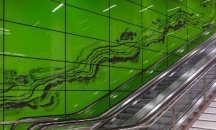Ad-free art on the underground: Düsseldorf's new metro line
Date uploaded: March 2, 2016
Germany’s first art on the underground project, a collaboration between artists, engineers and architects has opened in the city of Düsseldorf. Fifteen years in the making, the Wehrhahn metro line consists of six new stations running east to west beneath the city centre, collaboratively designed by architects, artists and engineers.
The project started in 2001 when a joint proposal by Klussmann and Darmstadt-based architecture practice Netzwerkarchitekten won an EU-wide, two-stage competition to design the stations. They commissioned five artists to develop concepts and have spent €843m (£657m) on two miles of tunnel boring and excavation, resulting in stations that are surprising and ambitious.
There have been other art on the underground projects but two factors make this one stand out: the total lack of advertising throughout, and the cohesive vision of a common architectural language.
In every station is the “continuum”, an etched concrete skin on all or part of the concourse walls with geometric shapes that expand and contract to create the illusion of three-dimensionality and movement, Klussmann explains. The idea was that there should be two layers to the project: “One layer that connects the stations to one another and another layer that responds to the urban context above ground,” says Markus Schwieger of Netzwerkarchitekten, who was part of the main coordinating team.
High street-level density means there are no buildings or ticketing facilities above ground; just staircases and escalators taking communtors down to an expansive space. These entrances were conceived as three-dimensional “incisions” – some have light shafts that let in natural daylight, and all provide dramatic cutaway views down on to the concourse and through to the escalators.
The station designed by Ralf Brög has three atmospheric sound corridors exploring noise sculpturally and visually, while Ursula Damm’s station features aerial views of Düsseldorf in the entrance. There is also a giant LED wall overlooking the concourse displaying real-time footage of passing pedestrians overlaid with constantly changing geometric structures that respond to the movement of passengers.
At Graf-Adolf-Platz, artist Manuel Franke created an immersive journey where sweeping layers of green rock strata accompany passengers down to the concourse and combine hand-painting with laminated security glass. Klussmann’s graphic black-and-white designs for Pempelforter Straße station play with the architecture and boundaries of the space and traditional notions of perspective to a dazzling effect.
Thomas Stricker conceived Benrather Straße station as a space ship lined with six screens that offer 3D views of planets. The interiors are clad in embossed stainless steel.
To read more click here for the full story.

